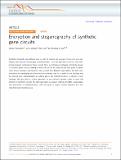Encryption and steganography of synthetic gene circuits
Author(s)
Purcell, Oliver; Wang, Jerry S.; Siuti, Piro; Lu, Timothy K
Downloads41467-018-07144-7.pdf (962.4Kb)
PUBLISHER_CC
Publisher with Creative Commons License
Creative Commons Attribution
Terms of use
Metadata
Show full item recordAbstract
Synthetic biologists use artificial gene circuits to control and engineer living cells. As engineered cells become increasingly commercialized, it will be desirable to protect the intellectual property contained in these circuits. Here, we introduce strategies to hide the design of synthetic gene circuits, making it more difficult for an unauthorized third party to determine circuit structure and function. We present two different approaches: the first uses encryption by overlapping uni-directional recombinase sites to scramble circuit topology and the second uses steganography by adding genes and interconnections to obscure circuit topology. We also discuss a third approach: to use synthetic genetic codes to mask the function of synthetic circuits. For each approach, we discuss relative strengths, weaknesses, and practicality of implementation, with the goal to inspire further research into this important and emerging area.
Date issued
2018-11Department
Institute for Medical Engineering and Science; Massachusetts Institute of Technology. Department of Biological Engineering; Massachusetts Institute of Technology. Department of Electrical Engineering and Computer Science; Massachusetts Institute of Technology. Department of Nuclear Science and Engineering; Massachusetts Institute of Technology. Research Laboratory of ElectronicsJournal
Nature Communications
Publisher
Nature Publishing Group
Citation
Purcell, Oliver, Jerry Wang, Piro Siuti, and Timothy K. Lu. “Encryption and Steganography of Synthetic Gene Circuits.” Nature Communications 9, no. 1 (November 22, 2018).
Version: Final published version
ISSN
2041-1723